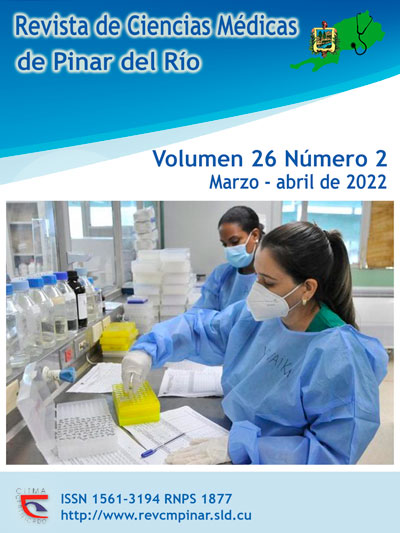Characteristics of patients with chronic renal failure and vascular accesses for hemodialysis
Keywords:
RENAL INSUFFICIENCY, CHRONIC, MORBIDITY AND MORTALITY, COMPLICATIONS, HEMODIALYSIS.Abstract
Introduction: chronic kidney disease is currently a worldwide health problem. Since the introduction of renal replacement therapy as a treatment for these patients, the number of patients with chronic kidney disease has been increasing and they require a safe and durable vascular access.
Objective: to characterize patients with chronic renal failure who underwent vascular access for hemodialysis at Abel Santamaria Cuadrado General Teaching Hospital in the period 2016-2020.
Methods: an observational, descriptive, cross-sectional study was conducted that included 115 patients intentionally chosen, meeting the inclusion criteria and undergoing vascular access for hemodialysis.
Results: male patients between 50 and 70 years old predominated, represented by 77 %; there was a predominance of patients with hypertensive nephropathy (63,48 %) in both male (41,74 %) and female (21,74 %); 79 % of the patients did not attend for timely medical care; the first surgery was performed after starting hemodialysis through a central venous catheter; only 21 % had permanent vascular access initially.
Conclusions: prevalence of male sex and hypertensive nephropathy as primary cause of chronic renal failure and hemodialysis. Most of patients in their first hemodialysis did not have permanent vascular access, being necessary to refer them to the Angiology specialty in pre-dialysis stages.
Downloads
References
1. Sociedad Española de Nefrología, informe anual [Internet]. 2019. [Citado 16/07/2021]. Disponible en: https://www.senefro.org/contents/webstructure/SEN_2019_REER_modificada.pdf
2. Ministerio de Salud Pública. Dirección de Registros Médicos y Estadísticas de Salud. Anuario Estadístico 2019. La Habana. MINSAP [Internet]. 2020 [Citado 16/07/2021]; Disponible en: Disponible en: http://files.sld.cu/bvscuba/files/2020/05/Anuario-Electrónico-Español-2019-ed-2020.pdf
3. Lok CE, Huber TS, Lee T, et al. KDOQI Vascular Access Guideline Work Group. KDOQI clinical practice guideline for vascular access:2019 Update. Am J Kidney Dis[Internet]. 2020 [Citado 16/07/2021]; 75(4)(suppl 2):S1-S164. Disponible en: https://www.sciencedirect.com/science/article/pii/S0272638619311370
4. Yeh LM, Chiu S, Lai PC. The Impact of vascular access types on hemodialysis patient long-term survival. Sc Rep [Internet]. 2019 [Citado 16/07/2021]; 9: 10708. Disponible en: https://www.ncbi.nlm.nih.gov/pmc/articles/PMC6656721/
5. Linares JC, Gotera J. Fístulas arterio-venosas en pacientes con insuficiencia renal crónica en hemodiálisis. Venezuela 2017-2018. Rev. de Ciencias de la Salud [Internet]. 2018 [Citado 16/07/2021]; 2(3):106-15. Disponible en: https://revistas.utm.edu.ec/index.php/QhaliKay/article/view/1613
6. Casares-Bran T, Olivares-Cruz S, Lecuona-Huert N, Fabián-Mijangos W, Rodríguez-López E, Betanco-Peña A, León-Rey C. Fístulas arterio-venosas para hemodiálisis: Tres años de experiencia en el Servicio de Angiología del Hospital General de México "Dr. Eduardo Liceaga". Rev Mex Angiol [Internet]. 2017 [Citado 16/07/2021]; 45(4):163-9. Disponible en: https://www.medigraphic.com/cgi-bin/new/resumen.cgi?IDARTICULO=77893
7. Suárez-Oropesa A, Martínez-Cutiño PM, Guillarte-Rojas CJ. Accesos vasculares en pacientes con Insuficiencia Renal Crónica en hemodiálisis. 16 de Abril [Internet]. 2020 [Citado 16/07/2021]; 59(277): e864. Disponible en: http://www.rev16deabril.sld.cu/index.php/16_04/article/view/864 .
8. Acosta-Arias Y. Accesos vasculares para hemodiálisis. Arch Hosp Calixto García. [Internet]. 2019[Citado 16/07/2021]; 7(1):77-83. Disponible en: www.revcalixto.sld.cu/index.php/ahcg/article/view/356/279
9. Martínez-Ginarte G, Guerra-Domínguez. E, Pérez-Marín. D. Enfermedad renal crónica, algunas consideraciones actuales. Multimed [Internet]. 2020 Abr [Citado 16/07/2021]; 24(2): 464-469. Disponible en: http://scielo.sld.cu/scielo.php?script=sci_arttext&pid=S1028-48182020000200464&lng=es.
10. Sosa-Vázquez OR, Triana-Mantilla ME. Caracterización de los pacientes con fístulas arterio-venosas para hemodiálisis. Rev Cubana Angiol Cir Vasc [Internet]. 2020 Dic [Citado 16/07/2021]; 21(3): e132. Disponible en: http://scielo.sld.cu/scielo.php?script=sci_arttext&pid=S1682-00372020000300006&lng=es.
11. Fiterre-Lancis I, Suárez-Rubio C, Sarduy-Chapis RL, Castillo-Rodríguez B, Gutiérrez-García F., Sabournin-Castel N, et al. Factores de riesgo asociados con sepsis del acceso vascular de pacientes en hemodiálisis. Rev haban de cienc méd [Internet]. 2018[Citado 16/07/2021]; 17(2): 335-346. Disponible en: http://scielo.sld.cu/pdf/rhcm/v17n2/rhcm18218.pdf
12. Ibeas J, Roca R, Joaquín J, Moreno T, Moñux G, Martí A, et al. Guía clínica española del acceso vascular para hemodiálisis. Rev Nefrol [Internet]. 2017 [Citado 16/07/2021]; 37(1):1-177. Disponible en: https://www.revistanefrologia.com/es-guia-clinica-espanola-del-acceso-articulo-S0211699517302175
13. Buitrón-Proaño GA, Velasteguí-Toledo MG. Asociación del acceso vascular para hemodiálisis y la calidad de vida de los pacientes con enfermedad renal crónica avanzada [Tesis]. Quito, Ecuador: Pontificia Universidad Católica del Ecuador; [Internet]. 2019 [Citado 16/07/2021]. Disponible en: http://repositorio.puce.edu.ec/handle/22000/16781
14. Pelayo-Alonso R, Cagigas-Villoslada MJ, Martínez-Álvarez P, Cobo-Sánchez JL, Ibarguren-Rodríguez E, Sáinz-Alonso RA. Factores relacionados con el inicio no programado de hemodiálisis en pacientes seguidos en consulta ERCA. Enferm Nefrol [Internet]. 2020 Ene-Mar [Citado 16/07/2021]; 23(1): 68-74. Disponible en: http://scielo.isciii.es/scielo.php?script=sci_arttext&pid=S2254-28842020000100008
15. Molina-Alfonso S, Gutiérrez-García F, Orret-Cruz D. Comportamiento de las fístulas arteriovenosas para hemodiálisis en el anciano. Rev Cubana Cir [Internet]. 2015 Mar [Citado 16/07/2021]; 54(1): 25-33. Disponible en: http://scielo.sld.cu/scielo.php?script=sci_arttext&pid=S0034-74932015000100004&lng=es
Downloads
Published
How to Cite
Issue
Section
License
Authors who have publications with this journal agree to the following terms: Authors will retain their copyrights and grant the journal the right of first publication of their work, which will be publication of their work, which will be simultaneously subject to the Creative Commons Attribution License (CC-BY-NC 4.0) that allows third parties to share the work as long as its author and first publication in this journal are indicated.
Authors may adopt other non-exclusive license agreements for distribution of the published version of the work (e.g.: deposit it in an institutional telematic archive or publish it in a volume). Likewise, and according to the recommendations of the Medical Sciences Editorial (ECIMED), authors must declare in each article their contribution according to the CRediT taxonomy (contributor roles). This taxonomy includes 14 roles, which can be used to represent the tasks typically performed by contributors in scientific academic production. It should be consulted in monograph) whenever initial publication in this journal is indicated. Authors are allowed and encouraged to disseminate their work through the Internet (e.g., in institutional telematic archives or on their web page) before and during the submission process, which may produce interesting exchanges and increase citations of the published work. (See The effect of open access). https://casrai.org/credit/



